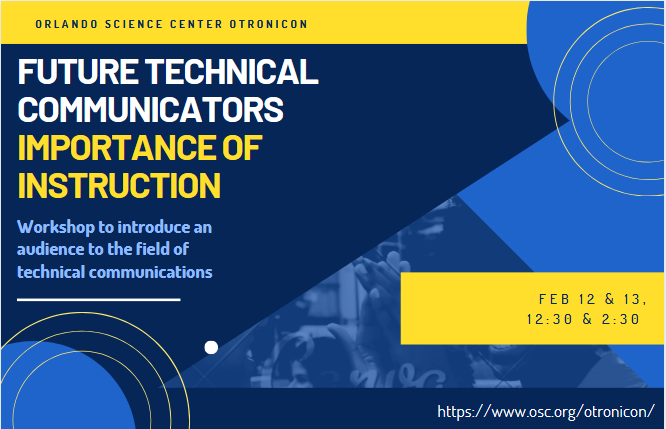By Alexandra Conte, FTC Publications Committee Member
Updated Spring 2023
Want to start blogging? Even better, want to get an article published on our FTC blog or our partner, STC Florida’s, newsletter? Start here for some tips!
Why create a blog post?
Blogs are short pieces of writing which can be informative and/or entertaining. Blog posts help you build an online presence for your career and highlight skills or topics you are learning about or already know. It is a low-stakes writing piece that takes little time and helps educate other students on various skills or issues in the field. Sometimes, you might also be learning about a topic as you put together a post. Blog posts can be put on your resume, and you can hyperlink a few examples for online resume submission. You can include your posts in a portfolio for entry-level jobs.
What is blogging?
Each post should assume the reader has five minutes or less to read, with a word count of around 250-500. As a result, the visual aspects of a blog post become more important than the writing itself. This is also reflected in the word count.
A blog post is less formal than most writing styles and has a lot of flexibility. For example, you can use first and second-person pronouns. It is common for writers to start their blog posts with questions for the reader to draw them in.
Steps for creating a blog post
- Pitch an idea
- Organize a few ideas for subpoints
- Create a rough draft
- Add subheadings
- Edit draft
- Add image(s)
- Add title
- Revise for overall consistency
- Add a tag or hashtag related to the content
Ways to make your post more dynamic
Navigation Aids:
- Title
- Subheadings (1-3)
- Bullet-points
Enhancement Aids:
- Images
- Graphs
- Maps
- Links to music
- Links to websites
Should I include a short bio?
Yes! Name, program, and what you’re studying. Position in FTC. List some research interests or things you want to learn about in the field. Include a fun fact or something you do outside of school.
Example: John Doe is a freshman studying Biology with a minor in Rhetoric and Composition. He is currently a member of FTC and STC. His interests are health and science, as well as editing. In his free time, John enjoys kayaking with his dog.
I want to blog for FTC; what is the next step?
- Email ucf.ftc@gmail.com and pitch an idea. If you still need to get an idea ready, you can email and ask if the Publications Committee has any article ideas that might interest you.
- Once you select a topic, provide an estimate or deadline of how long it will take you to complete the blog. There is no pressure to have one done quickly; take your time! We ask that you give us a general estimate so we know when to expect your post. We realize school gets busy; if something changes with your deadline, just email us.
- Work on your draft. Feel free to email us for advice or feedback.
- Submit your draft and a short bio through email.
- A Publications Committee member will edit your post to adhere to guidelines.
- After revision by the Publications Committee, your post will be uploaded to the FTC blog.
- Consider working with us to get your post published in other places, too, like the STC Florida newsletter!
*We often share new FTC articles on social media. Feel free to share our post or make your post on social media!
FTC Blog Style Guide
- General Information:
- Font: Sans Serif
- Size:
- Title: 16 pt
- Subheadings: 14 pt
- Text: 12 pt
- Spacing: Double
- Word Count for Posts: 250-500 words; more if needed
- Oxford Comma: Yes.
- Numbers:
- Spell out one to ten
- Underlining: Avoid.
- Common to hyperlink in blog posts which makes them harder to find.
- Bold: Only important information and subheadings.
- Acronyms: Spell out the first time you mention it, and place the acronym in parenthesis next to it. After this, you can use the acronym throughout the post.
- Example: The University of Central Florida (UCF) is one of the largest universities in the United States. Unlike other universities, UCF has two distinct mascots: Pegasus and Knightero. The Pegasus is the mascot of UCF as an institution, while Knightro is the mascot of the athletic program referred to as the Knights.
- Blog Post Format:
- Title of Blog Post
- Should have an action verb in the title.
- Demystifying the Myths of Technical Communication
- Should have an action verb in the title.
- Name of writer
- Specify your role in the club, and place your year and program in a line underneath. Italicize this information.
- Jane Doe, FTC Communications Committee Member
- Sophomore, Computer Science
- John Doe, FTC Member
- Second-Year English MA (Tech Comm Track)
- Jane Doe, FTC Communications Committee Member
- Specify your role in the club, and place your year and program in a line underneath. Italicize this information.
- Title of Blog Post
Content:
- Writing
- First Paragraph (3-4 sentences max)
- Hook
- Introduce the topic and where this post will go.
- Using open-ended questions is a common way to begin a post.
- Navigational Aid: Subheading 1
- Paragraph(s) A- Content A should remain the same and be no more than three short paragraphs.
- Navigational Aid: Subheading 2
- Paragraph(s) B- Content B should focus on one topic and be no more than three short paragraphs.
- Navigational Aid: Subheading 3
- Paragraph C
- Note: This is a sample; you do not need three subheadings with multiple paragraphs. Most of the time, posts fall between 1-3 subheadings.
- Conclusion:
- 1-2 sentence summary.
- Advise or invite the reader to do something.
- Sources:
- Most articles do not need sources. However, if you use them, place them at the bottom of the page under the subheading “Information gathered for this post was taken from _____.”
- Hyperlink sources to organizations.
- Most articles do not need sources. However, if you use them, place them at the bottom of the page under the subheading “Information gathered for this post was taken from _____.”
- First Paragraph (3-4 sentences max)
- Subheadings
- Subheadings are brief and are typically not complete sentences. It helps to bold the words.
- Example A: Get Creative
- Example B: When in Doubt, Go Green
- Subheadings are brief and are typically not complete sentences. It helps to bold the words.
*Note that visuals may be placed anywhere in the text.
Don’t forget to write a short bio with your name and what you’re studying. You can also lust your position in FTC. Another idea is to list some research interests or things you want to learn about in the field. Include a fun fact or something you do outside of school.
- Ex. Alex is a graduate-level English MA Technical Communication program student. She is a member of the Publications Committee. Her research experience typically focuses on health writing and project management strategies. Alex enjoys watching trashy reality television shows, reading, and drinking coffee in her free time.
Additional Resources:
- GLAAD Media Style Guide: Consult for best practices regarding the LGBTQ+ community and inclusive language.
- Associated Press Stylebook: Consult for best practices on inclusive language. Accessible through the UCF Library.


